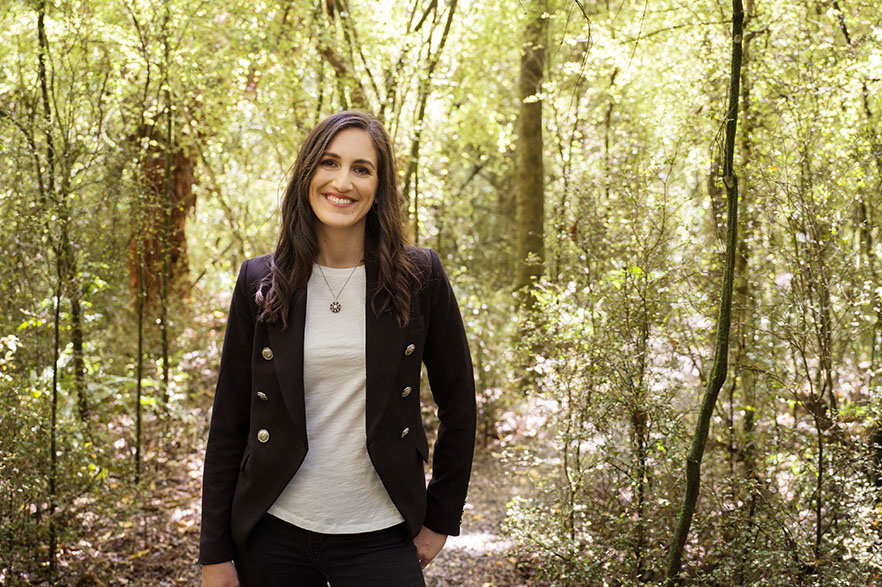Feature
Easing anxiety
As rates of anxiety increase worldwide, a new study from University of Otago neuroscientist Dr Olivia Harrison may hold the key to understanding anxiety better – from the inside out. With the backing of both a five-year Rutherford Discovery Fellowship and the 2021 L'Oréal-UNESCO For Women in Science Fellowship, she hopes to make a difference.
Anxiety – it's an all-too familiar feeling for many of us. Your heart starts to race, your palms go clammy, you suddenly feel like you can't breathe. And as the panic sets in, it all gets horribly worse.
It's a feeling Otago neuroscientist Dr Olivia Harrison knows intimately. As a member of the group she describes as the “worried well” – fully-functioning, healthy A-type personalities with above-average levels of anxiety – she is susceptible to feeling highly anxious when things go wrong.
But understanding the way the brain perceives those physical responses to anxiety, and how this communication between the brain and body can go awry to perpetuate a vicious loop of anxiety (anxiety-symptoms-more anxiety), may help develop treatments and techniques to help manage those symptoms better.
“It's about how we can treat those who are experiencing debilitating levels of anxiety, but also how we can protect these 'worried well' and keep us from tipping over, especially with all the chaos that's happening in the world,” says Harrison.
“We know certain levels of anxiety can be healthy for things such as self-awareness and self-protection, but as society continues to evolve, we are seeing anxiety occur at more disabling levels, and our coping strategies and treatments are lagging behind.
“Anxiety is unique to every individual and needs to be treated as such. The treatments that work well for some people do not work for everyone. We also know that many common treatments don't always last forever, and it may be because we are not giving people the necessary tools for their specific anxiety profile.”
Awarded a prestigious Rutherford Discovery Fellowship, along with the 2021 L'Oréal-UNESCO For Women in Science Fellowship, the study will look at how treatments such as exercise and anti-anxiety medication may help improve the brain's perception of anxiety symptoms. The five-year project builds on Harrison's earlier research, conducted while living in Switzerland, where she explored the way the brain processes breathing perceptions, and how this might be altered with greater levels of anxiety.
And with one in four New Zealanders at risk of developing mental health struggles, particularly women and younger people, understanding why certain strategies work with some people and not with others could help provide valuable insights into the treatment and management of anxiety.
“We know exercise can help for most people. But we don't know exactly how it's working. What happens to the brain? What happens to the way people perceive their body, and how might this help in the way they manage anxiety symptoms? And how can we break this down to help people a bit more – because someone who is in the middle of an anxiety crisis is not going to go out and join a gym class. What can we pull out of the effect of that intervention to create a first step, a mechanism that could help break the cycle of anxiety?”
Alongside the exercise study, Harrison and her team are also conducting a clinical study exploring the effect of the most commonly prescribed anti-anxiety medication (Selective Serotonin Reuptake Inhibitors, or SSRIs) on people diagnosed with anxiety.
“And if we better understand how exercise and medication really affects those anxiety symptoms, we may be able to provide some of those crucial 'baby steps' an individual in a crisis could take to help them feel better. And that will help all of us.”
“We look at them before and after six weeks of anti-anxiety medication. That's really important to know because, at the moment in New Zealand, the first port of call is often anti-anxiety medication. We know that SSRIs only work for some people and you have to wait a long time, usually at least six weeks to know if it's worked.
“That's a really long process for someone in crisis. By understanding the types of people or symptoms that SSRIs work for best, we hope to build up a better picture or profile of where SSRIs will make an impact.”
Harrison's journey back to Otago and her latest research has been a “wiggly road”, but she has always been interested in the connection between the brain and body. After graduating from the University of Otago in 2011 with a double degree in neuroscience and exercise science, she went to Oxford University to complete a doctorate in clinical neurosciences where she explored the brain's perception of breathlessness using brain imaging. Alongside this, Harrison has always been involved in the realm of high performance sport, working for a time with High Performance Sport New Zealand, and in Oxford researching both how we perceive our body while exercising, and how this information could be used to make us go faster, be stronger.
But she was sure the outcomes of her work could apply to more than just making an elite athlete go two per cent faster.
“I kept thinking, what if they're having a bad day? I needed to take a more holistic view.”
This change in focus led Harrison to Zurich, Switzerland in 2018, where she was awarded a European Union Marie Skłodowska-Curie Postdoctoral Fellowship ($NZ300,000) to study “the interoceptive link between anxiety and breathing perception” – or how anxiety may be related to the way we perceive our body signals.
“The field of interoception – the way we perceive signals from inside our body – has been a lesser-understood sense [compared to the exteroceptive or external senses, including the traditional five such as sight, hearing, touch, smell, taste] until more recently.
“But in the last 10 years, there's been a boom within psychiatry with a lot of studies exploring the relationship between mental health issues and disturbances in our body, and how we perceive these.

Otago Neuroscientist Dr Olivia Harrison received both a Rutherford Discovery Fellowship and the 2021 L'Oréal-UNESCO For Women in Science Fellowship last year.
“It makes a lot of sense. If you think about the last time you were really worried about something, you probably had all these thoughts rushing around in your head. But if you think about how you felt physically – you probably felt like your heart was racing, you might have been holding your breath, or breathing a bit faster. These repercussions of our thoughts happen inside our body.
“And what happens is that if we don't read those reactions properly, it perpetuates a cycle. We feel like we can't breathe, so we breathe faster, then we feel light-headed and worse. That inability to monitor what's actually going on and to use that information and interpret it, means that it can make the symptoms much worse.”
The Zurich study looked at two groups – the “worried well” (that term used for the group of fully functioning and healthy individuals with higher-than-average levels of anxiety) and a low anxiety group.
“We saw whopping differences between the groups,” says Harrison.
“People with higher levels of anxiety were less sensitive to changes in their bodies, they were less able to detect resistance in their breathing and had lower levels of insight into their performance, and also differences in their brain activity related to making predictions about breathing symptoms in the future.
“So now we want to explore what happens when you add an intervention – like exercise or medication – and how those perceptions change.”
Now back at Otago, Harrison is part of the IMAGE Otago Research Group (co-led with the School of Pharmacy's Associate Professor Bruce Russell) which uses behavioural and neuroimaging to investigate underlying mechanisms and treatment responses in mental health disorders. While Harrison's work is focused on anxiety and depression, Bruce looks at more severe mental illnesses such as schizophrenia, addiction and depression with an emphasis on treatment-resistance.
Harrison says the five-year Rutherford Fellowship allows the “gift of time” to her research – a rare gift in today's academic environment, or indeed, modern society.
“It means we can run longitudinal studies. I can run the study, do an intervention and then follow up on it.”
Harrison says they will have around 70 participants in each study. Working alongside primary carers and GPs, the clinical study has begun, with around five people through so far, while preparation for the exercise study is underway following a 20-person pilot study. This includes building on and perfecting the tests used from the Zurich study, exploring the latest MRI imaging techniques and deciding on what form the exercise intervention will take.
“It won't be some awful boot camp with a sergeant-major type shouting at you to do another burpee,” she laughs. “We need people to enjoy it as much as possible and to feel in control of their exercise. I am really lucky to be working with both Associate Professor Elaine Hargreaves and Professor Jim Cotter from the School of Physical Education, Sport and Exercise Sciences on the exercise side of things. Jim was my Honours supervisor back in the day, and Elaine has a wealth of knowledge in how to exercise to really make you feel good.”
Harrison hopes the study will provide valuable knowledge that will be useful both from an individual's perspective (knowledge is power, the more you understand what's going on inside you, the less scary it feels) and in treating the condition.
“I'm not a clinician, I'm a neuroscientist. This is an important adjunct to what is happening in that clinical environment.
“People want to know why a treatment they're prescribed works – 'it's going to help your anxiety' is not really enough. Knowing how something will help, the effect it has on your symptoms and brain's perception of what's happening inside you may motivate more people to try it.
“And if we better understand how exercise and medication really affects those anxiety symptoms, we may be able to provide some of those crucial 'baby steps' an individual in a crisis could take to help them feel better. And that will help all of us.”
Amie Richardson

